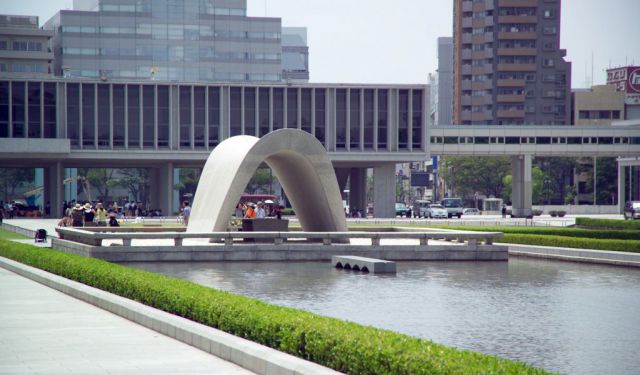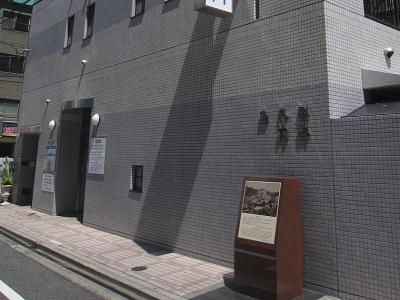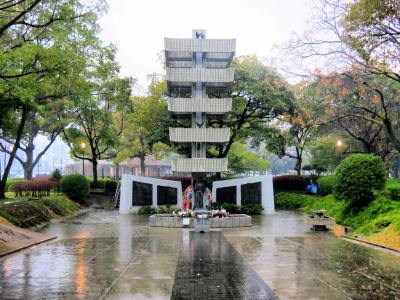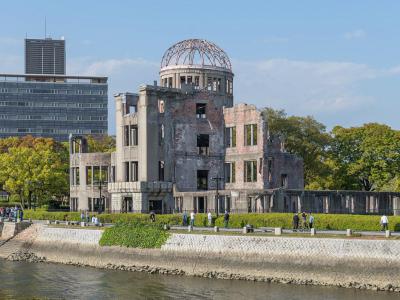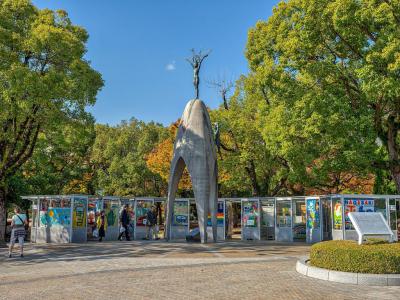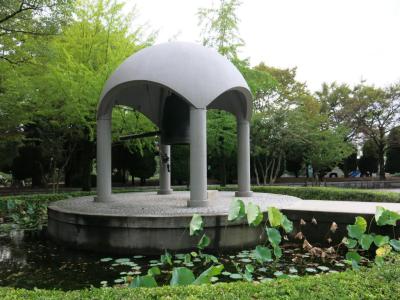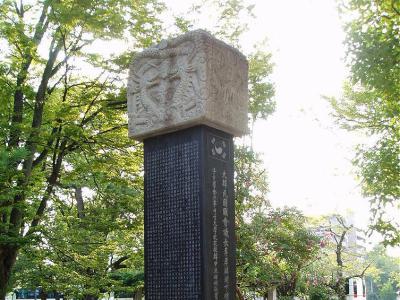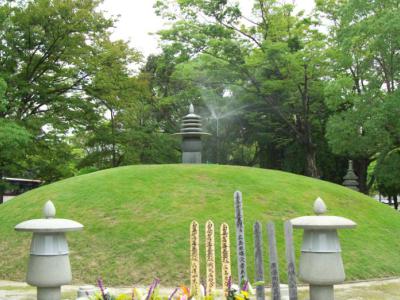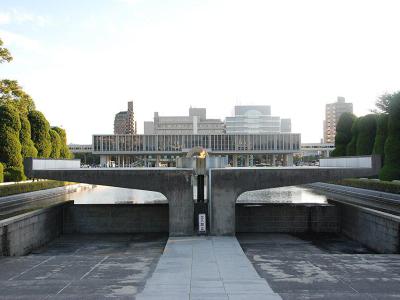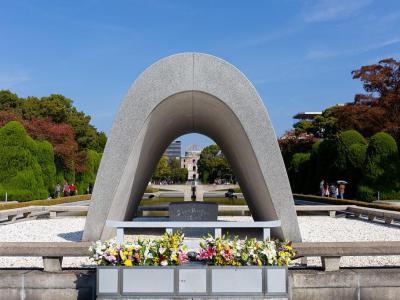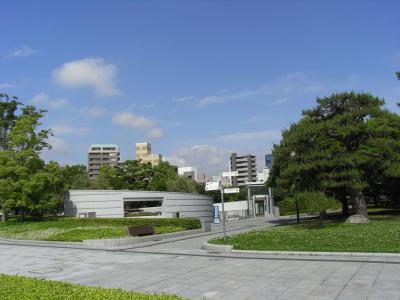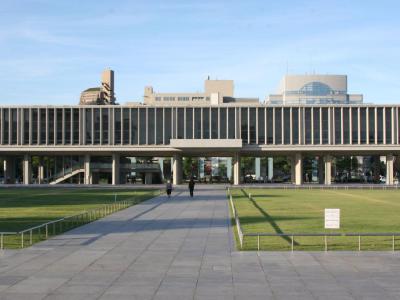Hiroshima Peace Memorial Tour (Self Guided), Hiroshima
Hiroshima Peace Memorial Park stands as a solemn testament to one of the darkest chapters in human history. This park is a haunting reminder of the catastrophic impact of nuclear warfare during World War II. Its grounds, marked by heart-wrenching attractions, bear witness to the immense suffering and loss that occurred on August 6, 1945.
Within this place of sorrow, the attractions etch the memories of that fateful day. The foremost of them, Ground Zero, is a chilling marker that designates the exact point where the atomic bomb's detonation unleashed unprecedented destruction.
Memorial Tower to the Mobilized Students pays tribute to the young souls who were coerced into wartime labor and met a tragic fate, forever bound to a war of not their choosing.
The iconic Atomic Bomb Dome is what remains of the Hiroshima Prefectural Industrial Promotion Hall. Its eerie silhouette has been preserved in a ravaged state as an indelible sign of resilience among ruins.
Amidst the shadows, a statue of a young girl named Sadako Sasaki clings to a paper crane, symbolizing yearning for a world without suffering. Known as the Children's Peace Monument, this is a touching tribute to the innocent lives forever altered.
A silent acknowledgment of the countless lives lost in the engulfing inferno, regardless of nationality, is the Cenotaph for Korean Victims. Beneath the Atomic Bomb Memorial Burial Mound rest the remains of nameless souls. Their stories are lost, but they found solace in this hallowed ground.
Echoes of grief resound through the Peace Bells rung by visitors to the park, while the flickering Flame of Peace stands as a fragile beacon of hope.
Hiroshima Peace Memorial Park serves as an enduring tribute to the unfathomable suffering that transpired within its boundaries, a place of somber reflection where history's wounds are both remembered and healed. As we contemplate the past, let us also heed the call to action it presents - an urgent reminder to work tirelessly for a world that renounces the destructive power of nuclear weapons and embraces the path of dialogue, cooperation, and lasting peace.
Within this place of sorrow, the attractions etch the memories of that fateful day. The foremost of them, Ground Zero, is a chilling marker that designates the exact point where the atomic bomb's detonation unleashed unprecedented destruction.
Memorial Tower to the Mobilized Students pays tribute to the young souls who were coerced into wartime labor and met a tragic fate, forever bound to a war of not their choosing.
The iconic Atomic Bomb Dome is what remains of the Hiroshima Prefectural Industrial Promotion Hall. Its eerie silhouette has been preserved in a ravaged state as an indelible sign of resilience among ruins.
Amidst the shadows, a statue of a young girl named Sadako Sasaki clings to a paper crane, symbolizing yearning for a world without suffering. Known as the Children's Peace Monument, this is a touching tribute to the innocent lives forever altered.
A silent acknowledgment of the countless lives lost in the engulfing inferno, regardless of nationality, is the Cenotaph for Korean Victims. Beneath the Atomic Bomb Memorial Burial Mound rest the remains of nameless souls. Their stories are lost, but they found solace in this hallowed ground.
Echoes of grief resound through the Peace Bells rung by visitors to the park, while the flickering Flame of Peace stands as a fragile beacon of hope.
Hiroshima Peace Memorial Park serves as an enduring tribute to the unfathomable suffering that transpired within its boundaries, a place of somber reflection where history's wounds are both remembered and healed. As we contemplate the past, let us also heed the call to action it presents - an urgent reminder to work tirelessly for a world that renounces the destructive power of nuclear weapons and embraces the path of dialogue, cooperation, and lasting peace.
How it works: Download the app "GPSmyCity: Walks in 1K+ Cities" from Apple App Store or Google Play Store to your mobile phone or tablet. The app turns your mobile device into a personal tour guide and its built-in GPS navigation functions guide you from one tour stop to next. The app works offline, so no data plan is needed when traveling abroad.
Hiroshima Peace Memorial Tour Map
Guide Name: Hiroshima Peace Memorial Tour
Guide Location: Japan » Hiroshima (See other walking tours in Hiroshima)
Guide Type: Self-guided Walking Tour (Sightseeing)
# of Attractions: 11
Tour Duration: 1 Hour(s)
Travel Distance: 1.1 Km or 0.7 Miles
Author: gene
Sight(s) Featured in This Guide:
Guide Location: Japan » Hiroshima (See other walking tours in Hiroshima)
Guide Type: Self-guided Walking Tour (Sightseeing)
# of Attractions: 11
Tour Duration: 1 Hour(s)
Travel Distance: 1.1 Km or 0.7 Miles
Author: gene
Sight(s) Featured in This Guide:
- Ground Zero
- Memorial Tower to the Mobilized Students
- Atomic Bomb Dome
- Children's Peace Monument
- Peace Bells
- Cenotaph for Korean Victims
- Atomic Bomb Memorial Burial Mound
- Flame of Peace
- Memorial Cenotaph
- Hiroshima National Peace Memorial Hall
- Hiroshima Peace Memorial Museum
1) Ground Zero
Ground Zero in Hiroshima holds a somber significance as the epicenter of the devastating atomic bombing that occurred on August 6, 1945. This marked site, located on a side street behind the A-bomb dome, stands as a poignant reminder of the destructive power of warfare and prompts deep contemplation on the necessity of such acts.
At this unassuming location, a stone plaque signifies the precise spot where the bomb was dropped, forever altering the course of history and leaving an indelible mark on the city and its people. The A-bomb dome, once the Hiroshima Prefectural Industrial Promotion Hall, stands as a haunting testament to the immense destruction unleashed by the bomb. It is a skeletal structure, preserved in its ruined state, symbolizing the resilience of humanity and the desire for peace.
Visiting Ground Zero in Hiroshima evokes a range of emotions. The sense of loss and tragedy is palpable as one stands in the place where countless lives were irrevocably changed. The sight of the A-bomb dome, with its shattered remnants frozen in time, serves as a stark reminder of the horrors of war and the catastrophic consequences of nuclear weapons.
The experience at Ground Zero compels visitors to question the necessity of war. It ignites a profound reflection on the choices made by humanity, the devastating consequences they can bring, and the urgent need to pursue peaceful solutions to conflicts. The humble nature of the site and its surroundings amplifies the gravity of the event, emphasizing the futility of war and the imperative for global cooperation and understanding.
At this unassuming location, a stone plaque signifies the precise spot where the bomb was dropped, forever altering the course of history and leaving an indelible mark on the city and its people. The A-bomb dome, once the Hiroshima Prefectural Industrial Promotion Hall, stands as a haunting testament to the immense destruction unleashed by the bomb. It is a skeletal structure, preserved in its ruined state, symbolizing the resilience of humanity and the desire for peace.
Visiting Ground Zero in Hiroshima evokes a range of emotions. The sense of loss and tragedy is palpable as one stands in the place where countless lives were irrevocably changed. The sight of the A-bomb dome, with its shattered remnants frozen in time, serves as a stark reminder of the horrors of war and the catastrophic consequences of nuclear weapons.
The experience at Ground Zero compels visitors to question the necessity of war. It ignites a profound reflection on the choices made by humanity, the devastating consequences they can bring, and the urgent need to pursue peaceful solutions to conflicts. The humble nature of the site and its surroundings amplifies the gravity of the event, emphasizing the futility of war and the imperative for global cooperation and understanding.
2) Memorial Tower to the Mobilized Students
The Memorial Tower to the Mobilized Students is a solemn tribute to the students who died during World War II. Located near the Atomic Bomb Dome, the tower stands in a peaceful park and symbolizes the sacrifices made by these young individuals. Built in 1967, the 12-meter-tall tower consists of five tiers and aims to console the spirits of approximately 10 thousand students who lost their lives. These students were mobilized to address labor shortages, as mandated by the Student Labor Service Act of 1944.
The act required middle and high school students to engage in labor service, including working in munitions factories and participating in building demolitions. Tragically, on the day of the atomic bombing in Hiroshima City, around 6,300 out of approximately 8,400 students from national upper level schools perished, along with many other students working in various industries. To honor their memory, the Memorial Tower features a statue of the goddess of peace and four relief panels depicting the students' work.
Each year on August 6th, a solemn service takes place in front of the tower to remember the atomic bombing. This day serves as a time for reflection, remembrance, and unity, as people gather to pay their respects and reaffirm their commitment to peace. The construction of the tower was made possible through the efforts of bereaved families and their supporters. They compiled a comprehensive list of the deceased students and raised funds to build the memorial, seeking to ensure their sacrifice is never forgotten.
The act required middle and high school students to engage in labor service, including working in munitions factories and participating in building demolitions. Tragically, on the day of the atomic bombing in Hiroshima City, around 6,300 out of approximately 8,400 students from national upper level schools perished, along with many other students working in various industries. To honor their memory, the Memorial Tower features a statue of the goddess of peace and four relief panels depicting the students' work.
Each year on August 6th, a solemn service takes place in front of the tower to remember the atomic bombing. This day serves as a time for reflection, remembrance, and unity, as people gather to pay their respects and reaffirm their commitment to peace. The construction of the tower was made possible through the efforts of bereaved families and their supporters. They compiled a comprehensive list of the deceased students and raised funds to build the memorial, seeking to ensure their sacrifice is never forgotten.
3) Atomic Bomb Dome (must see)
The Atomic Bomb Dome, also known as the Hiroshima Peace Memorial, stands as a poignant symbol of remembrance and peace in Hiroshima, Japan. Located within the Hiroshima Peace Memorial Park, this iconic structure was designated a UNESCO World Heritage Site in 1996. The building serves as a solemn memorial to the thousands of lives lost in the devastating atomic bombing of Hiroshima during World War II.
On August 6, 1945, at 8:15 am, the first nuclear bomb used in warfare detonated almost directly above the Atomic Bomb Dome. Originally, the "T"-shaped Aioi Bridge was the intended target, but the bomb missed slightly, and the dome became the center of the blast. Remarkably, the actual center of the explosion was 490 feet (150 meters) away and 1,968 feet (600 meters) above the ground. Despite being located at the epicenter of the blast, the dome's skeletal remains withstood the destructive force, making it an enduring symbol of resilience and hope amid tragedy.
In the aftermath of the bombing, as Hiroshima began to rebuild, the fate of the Atomic Bomb Dome became a matter of controversy. Some locals wanted it torn down, considering it a painful reminder of the past. However, others passionately advocated for its preservation as a somber testament to the horrors of nuclear warfare and a plea for peace.
In 1966, after much debate, Hiroshima City made the decision to preserve the A-bomb Dome indefinitely. The initiative to conserve the structure was supported by both local and international efforts, seeking funds to ensure its preservation. To date, the Atomic Bomb Dome has undergone two preservation projects to maintain its historical integrity and ensure its lasting legacy.
On August 6, 1945, at 8:15 am, the first nuclear bomb used in warfare detonated almost directly above the Atomic Bomb Dome. Originally, the "T"-shaped Aioi Bridge was the intended target, but the bomb missed slightly, and the dome became the center of the blast. Remarkably, the actual center of the explosion was 490 feet (150 meters) away and 1,968 feet (600 meters) above the ground. Despite being located at the epicenter of the blast, the dome's skeletal remains withstood the destructive force, making it an enduring symbol of resilience and hope amid tragedy.
In the aftermath of the bombing, as Hiroshima began to rebuild, the fate of the Atomic Bomb Dome became a matter of controversy. Some locals wanted it torn down, considering it a painful reminder of the past. However, others passionately advocated for its preservation as a somber testament to the horrors of nuclear warfare and a plea for peace.
In 1966, after much debate, Hiroshima City made the decision to preserve the A-bomb Dome indefinitely. The initiative to conserve the structure was supported by both local and international efforts, seeking funds to ensure its preservation. To date, the Atomic Bomb Dome has undergone two preservation projects to maintain its historical integrity and ensure its lasting legacy.
4) Children's Peace Monument
The Children's Peace Monument stands as a poignant and heartfelt tribute to the innocent victims of the atomic bombing of Hiroshima, with a special focus on one brave young girl named Sadako Sasaki. This monument, which serves as a symbol of peace and hope, was meticulously designed by Japanese artists Kazuo Kikuchi and Kiyoshi Ikebe.
The story behind the creation of the Children's Peace Monument is deeply touching. In the aftermath of the atomic bombing, a fundraising campaign was initiated by Japanese school children, including Sadako's classmates, to construct a monument dedicated to the memory of the thousands of children who tragically lost their lives due to the horrific event. On May 5, 1958, known as Children's Day in Japan, the main statue of the monument, titled 'A-bomb Children,' was unveiled to the public.
At the top of the statue stands a representation of Sadako Sasaki, a young girl who captured the hearts of many with her courageous and inspiring story. Sadako was diagnosed with leukemia, often referred to as the "atomic bomb disease," a result of the radiation exposure from the bombing. While facing her illness, she took inspiration from a Japanese legend that folding a thousand origami cranes would grant a wish. Despite her frailty, Sadako devoted her days to folding paper cranes in the hope of a world without war and suffering.
Sadly, Sadako passed away at the tender age of twelve, having folded over a thousand cranes. Her indomitable spirit and wish for peace resonated with people worldwide, leading to the tradition of leaving origami cranes at the Children's Peace Monument as a symbol of hope, peace, and solidarity with the victims of war.
The story behind the creation of the Children's Peace Monument is deeply touching. In the aftermath of the atomic bombing, a fundraising campaign was initiated by Japanese school children, including Sadako's classmates, to construct a monument dedicated to the memory of the thousands of children who tragically lost their lives due to the horrific event. On May 5, 1958, known as Children's Day in Japan, the main statue of the monument, titled 'A-bomb Children,' was unveiled to the public.
At the top of the statue stands a representation of Sadako Sasaki, a young girl who captured the hearts of many with her courageous and inspiring story. Sadako was diagnosed with leukemia, often referred to as the "atomic bomb disease," a result of the radiation exposure from the bombing. While facing her illness, she took inspiration from a Japanese legend that folding a thousand origami cranes would grant a wish. Despite her frailty, Sadako devoted her days to folding paper cranes in the hope of a world without war and suffering.
Sadly, Sadako passed away at the tender age of twelve, having folded over a thousand cranes. Her indomitable spirit and wish for peace resonated with people worldwide, leading to the tradition of leaving origami cranes at the Children's Peace Monument as a symbol of hope, peace, and solidarity with the victims of war.
5) Peace Bells
In the serene and hallowed grounds of Hiroshima Peace Park three Peace Bells stand as resonant symbols of hope, unity, and a shared vision for a world free from the ravages of war. Among these bells, the most renowned and iconic one captures the attention of visitors from near and far.
The Peace Bell, a magnificent creation dating back to 1964, is an awe-inspiring sight. Housed inside a small open-sided structure, this large Japanese bell holds a profound significance. With each melodious toll, the Peace Bell resounds throughout the park, reaching the hearts of all who hear it. The act of ringing the bell not only stands as a gesture of remembrance for the victims of the atomic bombing but also serves as a collective commitment to a future devoid of conflict and violence.
Designed by the talented artist Masahiko Katori, the surface of the bell holds a striking representation of the world. A map of the globe serves as a poignant reminder of the interconnectedness of all humanity, emphasizing the need for global cooperation and understanding. At the heart of the bell's design lies an atomic symbol, a solemn reminder of the profound consequences of nuclear warfare.
Inscribed on the bell are words that transcend language barriers. In Greek, Japanese, and Sanskrit, the inscription reads "Know yourself." This deeply philosophical message, attributed to the great thinker Socrates, serves as a profound call for self-reflection and introspection. It reminds us that understanding ourselves and our own motivations is essential in striving for a peaceful world.
The Peace Bell, a magnificent creation dating back to 1964, is an awe-inspiring sight. Housed inside a small open-sided structure, this large Japanese bell holds a profound significance. With each melodious toll, the Peace Bell resounds throughout the park, reaching the hearts of all who hear it. The act of ringing the bell not only stands as a gesture of remembrance for the victims of the atomic bombing but also serves as a collective commitment to a future devoid of conflict and violence.
Designed by the talented artist Masahiko Katori, the surface of the bell holds a striking representation of the world. A map of the globe serves as a poignant reminder of the interconnectedness of all humanity, emphasizing the need for global cooperation and understanding. At the heart of the bell's design lies an atomic symbol, a solemn reminder of the profound consequences of nuclear warfare.
Inscribed on the bell are words that transcend language barriers. In Greek, Japanese, and Sanskrit, the inscription reads "Know yourself." This deeply philosophical message, attributed to the great thinker Socrates, serves as a profound call for self-reflection and introspection. It reminds us that understanding ourselves and our own motivations is essential in striving for a peaceful world.
6) Cenotaph for Korean Victims
The Cenotaph for Korean Victims in Hiroshima stands as a solemn and poignant tribute to a group of victims whose plight has been historically neglected. Among the staggering number of people who perished or suffered from the devastating consequences of the atomic bomb explosion in Hiroshima, at least 45,000 were Korean. However, the true extent of the Korean victims remains uncertain, as they were often marginalized as a minority population.
Adding to the historical significance of this monument is the fact that after the liberation from Japanese colonialism, around 300,000 survivors of the Hiroshima and Nagasaki bombings returned to Korea, seeking to rebuild their lives in the aftermath of the harrowing experiences they endured.
The Cenotaph, adorned with Korean national symbols, serves a profound purpose - to honor the memory of the Korean victims and survivors of both the atomic bomb and the oppressive Japanese colonial rule.
Inscribed upon the monument are powerful and poignant words that pay homage to the lost souls. The main inscription reads, "The Monument in Memory of the Korean Victims of the A-Bomb. In memory of the souls of His Highness Prince Yi Wu and over 20,000 other souls." Additionally, a side-inscription adds to the emotional depth of the monument, stating, "Souls of the dead ride to heaven on the backs of turtles." This evocative imagery symbolizes a traditional belief in Korea, reflecting a profound sense of spirituality and reverence for those who have departed.
The Cenotaph for Korean Victims serves as a poignant reminder of the tragic consequences of war and the importance of acknowledging all the victims, regardless of their background or origin.
Adding to the historical significance of this monument is the fact that after the liberation from Japanese colonialism, around 300,000 survivors of the Hiroshima and Nagasaki bombings returned to Korea, seeking to rebuild their lives in the aftermath of the harrowing experiences they endured.
The Cenotaph, adorned with Korean national symbols, serves a profound purpose - to honor the memory of the Korean victims and survivors of both the atomic bomb and the oppressive Japanese colonial rule.
Inscribed upon the monument are powerful and poignant words that pay homage to the lost souls. The main inscription reads, "The Monument in Memory of the Korean Victims of the A-Bomb. In memory of the souls of His Highness Prince Yi Wu and over 20,000 other souls." Additionally, a side-inscription adds to the emotional depth of the monument, stating, "Souls of the dead ride to heaven on the backs of turtles." This evocative imagery symbolizes a traditional belief in Korea, reflecting a profound sense of spirituality and reverence for those who have departed.
The Cenotaph for Korean Victims serves as a poignant reminder of the tragic consequences of war and the importance of acknowledging all the victims, regardless of their background or origin.
7) Atomic Bomb Memorial Burial Mound
The Atomic Bomb Memorial Burial Mound stands as a poignant testament to the devastating impact of the atomic bomb on Hiroshima. Located within the serene confines of the Peace Memorial Park, this grass-covered knoll serves as the resting place for the cremated ashes of approximately 70,000 unidentified victims of the bomb.
Below the surface of the gentle mound lies a vault that holds the remains of thousands of unclaimed or unidentified victims. These individuals, tragically rendered nameless by the destructive forces unleashed upon the city, find their final resting place within this solemn memorial.
The Atomic Bomb Memorial Mound carries profound significance, not only as a burial site but also as a symbol of the immense suffering experienced by the people of Hiroshima. The horrific nature of the atomic bomb's impact left many victims beyond recognition, their bodies charred and disfigured. Consequently, their identities were lost, leaving their loved ones unable to mourn them properly or provide them with individualized resting places.
In addition to the harrowing destruction caused by the blast, the intense heat and subsequent fires that engulfed Hiroshima caused unbearable thirst among the victims. As they faced unimaginable pain and impending death, countless individuals pleaded for water to quench their unyielding thirst. As a testament to this heartbreaking aspect of the tragedy, mourners often leave glasses or bottles of water near the memorial mound, a symbolic gesture honoring the victims' final moments and their desperate cries for relief.
The site stands as a solemn place of reflection, inviting visitors from around the world to pay their respects and contemplate the devastating consequences of nuclear warfare. It serves as a poignant reminder of the horrors of the past, urging us to work towards a future where such tragedy is never repeated.
Below the surface of the gentle mound lies a vault that holds the remains of thousands of unclaimed or unidentified victims. These individuals, tragically rendered nameless by the destructive forces unleashed upon the city, find their final resting place within this solemn memorial.
The Atomic Bomb Memorial Mound carries profound significance, not only as a burial site but also as a symbol of the immense suffering experienced by the people of Hiroshima. The horrific nature of the atomic bomb's impact left many victims beyond recognition, their bodies charred and disfigured. Consequently, their identities were lost, leaving their loved ones unable to mourn them properly or provide them with individualized resting places.
In addition to the harrowing destruction caused by the blast, the intense heat and subsequent fires that engulfed Hiroshima caused unbearable thirst among the victims. As they faced unimaginable pain and impending death, countless individuals pleaded for water to quench their unyielding thirst. As a testament to this heartbreaking aspect of the tragedy, mourners often leave glasses or bottles of water near the memorial mound, a symbolic gesture honoring the victims' final moments and their desperate cries for relief.
The site stands as a solemn place of reflection, inviting visitors from around the world to pay their respects and contemplate the devastating consequences of nuclear warfare. It serves as a poignant reminder of the horrors of the past, urging us to work towards a future where such tragedy is never repeated.
8) Flame of Peace
The Flame of Peace in Hiroshima is a symbol of hope and remembrance, representing the desire for a world without nuclear weapons. Located in Hiroshima Peace Memorial Park, this monument attracts visitors worldwide who come to pay their respects and promote peace. The flame burns on a stone platform shaped like hands, symbolizing the resilience of atomic bomb victims. It serves as a constant reminder to eliminate nuclear weapons.
For more than 75 years, since the end of World War II, the "Flame of Peace" has held its vigil, fueling the aspirations of those who seek a future free from the horrors of nuclear warfare.
The monument, along with the Atomic Bomb Dome, creates a solemn experience that deepens the understanding of the devastating consequences of nuclear warfare. The "Flame of Peace" has become an international symbol of peace, drawing visitors to advocate for a nuclear-free world. Its eternal glow represents the hope for a peaceful future and inspires efforts towards global security.
For more than 75 years, since the end of World War II, the "Flame of Peace" has held its vigil, fueling the aspirations of those who seek a future free from the horrors of nuclear warfare.
The monument, along with the Atomic Bomb Dome, creates a solemn experience that deepens the understanding of the devastating consequences of nuclear warfare. The "Flame of Peace" has become an international symbol of peace, drawing visitors to advocate for a nuclear-free world. Its eternal glow represents the hope for a peaceful future and inspires efforts towards global security.
9) Memorial Cenotaph (must see)
The Memorial Cenotaph stands at the heart of the Hiroshima Peace Memorial Park, a powerful symbol of remembrance and a resolute commitment to a world free from the horrors of war. This concrete, saddle-shaped monument bears the weight of history, displaying the names of all those who tragically lost their lives to the devastating atomic bomb.
The epitaph etched onto the cenotaph solemnly reads, "Rest in Peace, for the error shall not be repeated." These words serve as a haunting reminder of the consequences of nuclear warfare and the profound loss experienced by the people of Hiroshima.
As one gazes through the center of the monument, an ethereal sight unfolds. The Peace Flame and the iconic A-Bomb Dome stand in the background, forming a poignant tableau of hope amidst the ruins of destruction. The Peace Flame, eternally burning, represents the city's unyielding desire for lasting peace, while the skeletal remains of the A-Bomb Dome bear witness to the tragic events of the past, serving as a powerful testament to the need for a world free from nuclear weapons.
The arch shape of the cenotaph carries a deeper significance. It symbolizes a shelter, a sanctuary for the souls of the victims, comforting them in their eternal rest and reminding the living of their solemn duty to ensure that such horrors are never repeated.
Every year on August 6th, a day known as "A-bomb Day," the City of Hiroshima holds the Hiroshima Peace Memorial Ceremony. This solemn event serves to console the victims of the atomic bombs and to pray for a world where peace prevails. Citizens, as well as the families of the deceased, come together to participate in this poignant ceremony.
At 8:15 am, the precise moment when the atomic bomb exploded over Hiroshima, one minute of silence is observed. The city stands still, as the present honors the past, remembering those whose lives were forever altered by the devastation of war.
The Memorial Cenotaph in Hiroshima stands as a testament to the resilience of the human spirit and the unyielding pursuit of peace. It serves as a place of reflection, healing, and unity for people from all walks of life, transcending borders and cultures.
The epitaph etched onto the cenotaph solemnly reads, "Rest in Peace, for the error shall not be repeated." These words serve as a haunting reminder of the consequences of nuclear warfare and the profound loss experienced by the people of Hiroshima.
As one gazes through the center of the monument, an ethereal sight unfolds. The Peace Flame and the iconic A-Bomb Dome stand in the background, forming a poignant tableau of hope amidst the ruins of destruction. The Peace Flame, eternally burning, represents the city's unyielding desire for lasting peace, while the skeletal remains of the A-Bomb Dome bear witness to the tragic events of the past, serving as a powerful testament to the need for a world free from nuclear weapons.
The arch shape of the cenotaph carries a deeper significance. It symbolizes a shelter, a sanctuary for the souls of the victims, comforting them in their eternal rest and reminding the living of their solemn duty to ensure that such horrors are never repeated.
Every year on August 6th, a day known as "A-bomb Day," the City of Hiroshima holds the Hiroshima Peace Memorial Ceremony. This solemn event serves to console the victims of the atomic bombs and to pray for a world where peace prevails. Citizens, as well as the families of the deceased, come together to participate in this poignant ceremony.
At 8:15 am, the precise moment when the atomic bomb exploded over Hiroshima, one minute of silence is observed. The city stands still, as the present honors the past, remembering those whose lives were forever altered by the devastation of war.
The Memorial Cenotaph in Hiroshima stands as a testament to the resilience of the human spirit and the unyielding pursuit of peace. It serves as a place of reflection, healing, and unity for people from all walks of life, transcending borders and cultures.
10) Hiroshima National Peace Memorial Hall
The Hiroshima National Peace Memorial Hall for the Atomic Bomb Victims, established in 2002, is a solemn memorial dedicated to remembering the victims of the atomic bomb that devastated Hiroshima during World War II. Designed by Kenzo Tange, the Hall is located in the Hiroshima Peace Memorial Park near the Motoyasu River. It serves as a place for reflection, education, and healing.
The Hall's primary objective is to preserve the memories and stories of the survivors, known as hibakusha. The curators actively engage with hibakusha, collecting their personal accounts of the bomb's impact to ensure that their experiences are passed down to future generations.
Additionally, the curators gather names and photographs of the atomic bomb victims, honoring their memory and providing a tangible representation of the human toll. This information is compiled to create a comprehensive archive, allowing visitors to connect with the personal stories behind the statistics.
Through a project called "reading the stories of the atomic bombing," the curators analyze testimonies, photographs, and names to gain a deeper understanding of the human impact of the bomb. This initiative helps researchers and visitors develop a more empathetic appreciation for the immense suffering endured by the victims and their families.
A notable aspect of the Hall is that admission is free, emphasizing the commitment to ensuring accessibility for all who wish to learn from the past.
The Hall's primary objective is to preserve the memories and stories of the survivors, known as hibakusha. The curators actively engage with hibakusha, collecting their personal accounts of the bomb's impact to ensure that their experiences are passed down to future generations.
Additionally, the curators gather names and photographs of the atomic bomb victims, honoring their memory and providing a tangible representation of the human toll. This information is compiled to create a comprehensive archive, allowing visitors to connect with the personal stories behind the statistics.
Through a project called "reading the stories of the atomic bombing," the curators analyze testimonies, photographs, and names to gain a deeper understanding of the human impact of the bomb. This initiative helps researchers and visitors develop a more empathetic appreciation for the immense suffering endured by the victims and their families.
A notable aspect of the Hall is that admission is free, emphasizing the commitment to ensuring accessibility for all who wish to learn from the past.
11) Hiroshima Peace Memorial Museum (must see)
The Hiroshima Peace Memorial Museum stands as a powerful testament to the devastating impact of the atomic bomb and serves as a poignant reminder of the urgent need for peace and nuclear disarmament. Established in 1955, the museum's mission is to communicate the reality of the damage caused by the atomic bomb to people worldwide and to advocate for the abolition of nuclear weapons and the attainment of lasting global peace, at the very core of Hiroshima's essence.
On the fateful morning of August 6, 1945, at 8:15 am, Hiroshima became the first city in the world to suffer the catastrophic consequences of an atomic bomb. The unimaginable devastation resulted in the destruction of most of the city and the loss of countless lives. Those who miraculously survived the bombing endured severe physical and psychological trauma, with many A-bomb survivors continuing to suffer to this day.
The Hiroshima Peace Memorial Museum collects and displays an array of poignant photographs and artifacts, showcasing the grim remains of the A-bomb survivors and the devastation caused by the bomb's explosion. The exhibits also chronicle the history of Hiroshima before and after the bombing and offer insights into the broader context of the nuclear age. Through its thought-provoking displays, the museum offers visitors a deep understanding of the profound consequences of nuclear warfare and the impact on human lives.
Additionally, the museum plays an active role in preserving the stories of A-bomb survivors by organizing lectures where survivors share their experiences. These first-hand accounts serve as powerful testimonials, fostering empathy and understanding among visitors, and emphasizing the importance of peace and reconciliation.
On the fateful morning of August 6, 1945, at 8:15 am, Hiroshima became the first city in the world to suffer the catastrophic consequences of an atomic bomb. The unimaginable devastation resulted in the destruction of most of the city and the loss of countless lives. Those who miraculously survived the bombing endured severe physical and psychological trauma, with many A-bomb survivors continuing to suffer to this day.
The Hiroshima Peace Memorial Museum collects and displays an array of poignant photographs and artifacts, showcasing the grim remains of the A-bomb survivors and the devastation caused by the bomb's explosion. The exhibits also chronicle the history of Hiroshima before and after the bombing and offer insights into the broader context of the nuclear age. Through its thought-provoking displays, the museum offers visitors a deep understanding of the profound consequences of nuclear warfare and the impact on human lives.
Additionally, the museum plays an active role in preserving the stories of A-bomb survivors by organizing lectures where survivors share their experiences. These first-hand accounts serve as powerful testimonials, fostering empathy and understanding among visitors, and emphasizing the importance of peace and reconciliation.
Walking Tours in Hiroshima, Japan
Create Your Own Walk in Hiroshima
Creating your own self-guided walk in Hiroshima is easy and fun. Choose the city attractions that you want to see and a walk route map will be created just for you. You can even set your hotel as the start point of the walk.
Hiroshima Introduction Walking Tour
Tucked away within the contours of Japan's southwestern expanse, the green and picturesque city of Hiroshima emerges as a profound testament to history's arc and an unwavering beacon of hope for a world united in harmony.
Composed of two kanji characters: "hiro", which means "wide" or "broad," and "shima", which means "island," the... view more
Tour Duration: 2 Hour(s)
Travel Distance: 3.8 Km or 2.4 Miles
Composed of two kanji characters: "hiro", which means "wide" or "broad," and "shima", which means "island," the... view more
Tour Duration: 2 Hour(s)
Travel Distance: 3.8 Km or 2.4 Miles
The Most Popular Cities
/ view all
